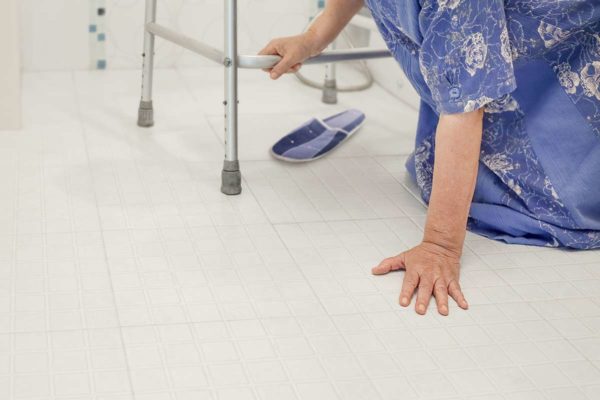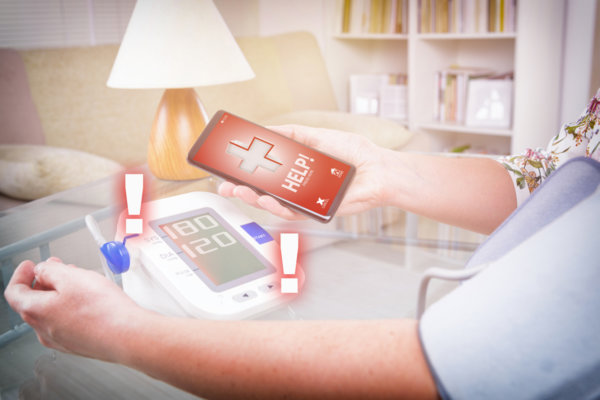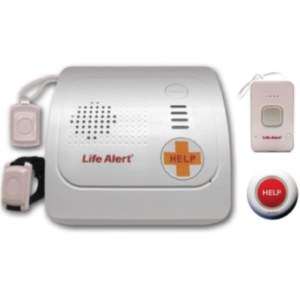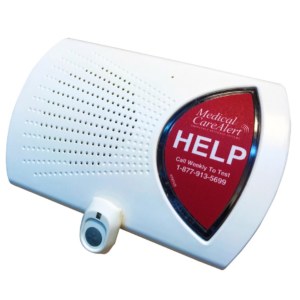Life Alert Vs. Medical Alert: Which System Will Keep You Safest?
There may come a time when you realize that you or your loved one are at a heightened risk for falls or medical emergencies. This can bring you to a crossroads: should you consider an assisted living facility, or is there a way to age in place safely?
The best medical alert systems enable people to remain in their homes, by providing instant access to help at the push of a button. With a medical alert system, you can reach help even if a phone is not nearby. Medical alert systems also provide on-the-go options for active folks. Some include fall protection, a key feature.
You may be considering two well-known medical alert systems, Life Alert versus Medical Alert. Both companies are well established and have been helping keep people safe at home for many years.
There are some very significant differences between the services provided by Medical Alert and Life Alert. Read on to learn all about the systems these companies offer, including costs, features, and more.
Why You Can Trust Our Expert Review
Our experts independently research and recommend products we believe provide value in the lives of our readers. We’ve spent collectively more than 1,700 hours conducting in-depth research on medical alert systems. To make our picks, here’s what we did:
- Engaged in ongoing independent research
- Consulted with geriatricians and adult caregivers
- Mystery shopped the brands
- Surveyed medical alert system users
- Tested various medical alert systems
- Interviewed experts in the field
- Read hundreds of verified customer reviews from trusted third parties such as Better Business Bureau and
Consumer Reports
Life Alert vs. Medical Alert – Comparisons at a Glance
| Costs and Features |
| Upfront Equipment Fee | |
| Life Alert | none |
|---|---|
| Medical Alert | None |
| Monthly Cost | |
| Life Alert | Starts at $69 monthly |
|---|---|
| Medical Alert | Starts at $19.95 mont |
| Activation Fee | |
| Life Alert | $298 |
|---|---|
| Medical Alert | $49 |
| Contract | |
| Life Alert | Three-year contract |
|---|---|
| Medical Alert | None |
| Add-On Services | |
| Life Alert | None |
|---|---|
| Medical Alert | Protection plan, lockbox, fall protection |
| Connection | |
| Life Alert | Landline, cellular, GPS |
|---|---|
| Medical Alert | Landline, AT&T cellular, GPS |
| Wall Mount Buttons | |
| Life Alert | Yes |
|---|---|
| Medical Alert | No |
| Two-Way Communication | |
| Life Alert | Yes |
|---|---|
| Medical Alert | Yes |
| Battery Life | |
| Life Alert | 7-10 years for GPS buttons, 72-hour backup base battery |
|---|---|
| Medical Alert | 30-hour backup base battery |
| Water Resistance | |
| Life Alert | Yes |
|---|---|
| Medical Alert | Yes |
| Fall Detection | |
| Life Alert | None offered |
|---|---|
| Medical Alert | Yes, for $10 month additional |
| GPS Locator | |
| Life Alert | Yes |
|---|---|
| Medical Alert | Yes |
| Call Center Hours | |
| Life Alert | 24/7 |
|---|---|
| Medical Alert | 24/7 |
Life Alert Overview

Life Alert is an American, family-owned medical alert company. It’s best known for its iconic “I’ve fallen and I can’t get up” television commercials.
Life Alert offers an at-home medical alert system that can be bundled with on-the-go GPS monitoring. The system can be connected to your own landline or to Life Alert’s cellular network.
Unlike Medical Alert, Life Alert does not offer automatic fall detection. A company representative said they don’t provide this service because it generates too many false alarms.
Life Alert doesn’t have an app that clients and their caregivers can use for added connectivity. The Life Alert system doesn’t include extras such as step tracking, wellness checks, or medication reminders.
Life Alert requires that users sign a three-year contract. According to the company, the contract can be canceled without penalty only if the client can prove that they are no longer capable of independent living. Some user reviews express extreme difficulty canceling their contracts, although it’s hard to say how widespread issues around contract termination may be.
Life Alert doesn’t post its costs or packages online, which creates a lack of transparency that can be troubling. It’s also difficult to reach or speak to a sales representative. We called several times and spoke to people who couldn’t provide information about costs or services. The costs and package types we were finally quoted by a friendly representative differed from what we’ve seen posted on various websites.
Life Alert’s call center is available 24/7. According to a Life Alert representative, their approximate response time is 30 seconds, far longer than the response time reported by many other medical alert systems.
Who Is Life Alert For?
Life Alert offers a simple system that doesn’t have many bells and whistles. If you are not comfortable with technology or don’t need added features, you may like what they have to offer.
Life Alert’s waterproof call button makes this system a good choice for anyone who wants added protection in the bathroom. The button can be placed in other areas of the home as well.
The lack of an app, step tracker, and medication reminders may make Life Alert less attractive to tech-savvy seniors and those who are active outside the home.

Concerns about falls are one of the primary reasons people look for medical alert systems. According to the CDC, millions of people over 65 take a fall annually. One out of 5 falls result in serious injuries, including head injuries that cause loss of consciousness. It’s hard to predict whether a fall will be catastrophic, but certain conditions make falling due to loss of consciousness more likely. They include:
- Epilepsy
- Stroke
- Low blood pressure
- Taking certain medications, such as diuretics or calcium channel blockers
- Diabetes
People with these conditions may not be a good fit for Life Alert.
What Are the Costs of Life Alert?
Life Alert charges a set-up fee of $298. A technician will come to your home and do the installation for you. Alternatively, a technician can walk you through the setup process over the phone. There is no additional equipment fee required.
The at-home package costs $69 monthly. If you add GPS tracking for on-the-go protection, your cost will be $90 monthly.
Pros and Cons of Life Alert
Pros
-
Long-life battery
-
Easy to use at-home system
-
Professional setup
-
Waterproof call button for the bathtub
Cons
-
No automatic fall detection
-
Higher monthly costs than some other medical alert systems
-
Long-term contract required that may be difficult to cancel
-
Expensive set-up fee
-
Longer-than-average response time
-
Must order the system over the phone
Different Plans and Models of Life Alert
Life Alert has one system that can be purchased as a standalone or with added GPS tracking.
If you don’t purchase GPS for outdoor protection, your package will include:
- A base unit that can be operated through a landline or cellular service
- A wearable help button that can be worn in a pendant or wristband
- A waterproof wall button
If you add on GPS tracking for outdoor use, you will also get:
- A mobile GPS unit that is about the size of a travel-size bar of soap
The base unit can be run through a landline, or through Life Alert’s cellular service. The at-home help button can be popped into a necklace or wristband. It has an 800 feet range and a 10-year battery life.
The waterproof wall button can be placed in the bathroom or in any room where you think it might be needed.
The GPS tracking unit can be worn or carried.
Medical Alert Overview

Medical Alert is a division of Connect America, a decades-old connected health solutions company. Medical Alert offers two medical alerts systems: one for at-home use and one for outdoor use. Both systems include optional fall detection for an additional fee. They also include an intuitive app that connects seniors to their caregivers.

Medical Alert’s response center is available 24/7, 365 days a year. According to the company, its response time is immediate, within single-digit seconds. The center is staffed by call operators that are fluent in many languages. They’re also trained to use the International Language Line to access real-time translations in 140 languages. This can save many precious seconds for non-English speakers in an emergency.
This service can also be highly valuable for English-as-a-second-language speakers who may be experiencing dementia. According to the Alzheimer’s Society, people often revert to their first learned language as dementia progresses. Even someone with sharp mental acuity may lean on the language they’re most comfortable with during stressful situations, such as a medical emergency or a fire.
The company maintains an anonymous hotline through Lighthouse Services, an outside vendor. Any client or caregiver can use this hotline to report unlawful behavior, elder abuse, or fraud that may have been perpetrated by a Medical Alert employee. This level of transparency and corporate responsibility sets Medical Alert apart from many of its competitors.
Who Is Medical Alert For?

Medical Alert is a good choice for people who spend most of their time at home, as well as for those who are active. Its system is easy to use but may also appeal to people who are comfortable with technology. The added fall protection is a big plus.
Medical Alert is budget-priced, especially when compared to Life Alert. Since there’s no contract, it may also have appeal for adult children looking for interim solutions that keep their parents safe at home for a finite period.
What Are the Costs of Medical Alert?
Medical Alert doesn’t lock you into a long-term contract, so you don’t have to worry about continuing to pay for a system you no longer need. You can pay by the month, semi-annually, or annually.
If you choose semi-annual billing, the at-home system costs $19.95 monthly if you connect through a landline, and $29.95 monthly if you connect through cellular service. Its on-the-go system starts at $39.95 monthly.
Fall detection is an additional $10 monthly add-on. Its protection plan is $1.00 a month. It protects your system against loss, damage, or theft.
Pros and Cons of Medical Alert
Pros
-
Fast response time
-
No contract or equipment fee
-
Available fall protection
-
Does not require professional installation
-
Call center operators who speak many languages
-
Budget-priced packages
-
Includes an easy-to-use app
-
Well-established and transparent company
-
30-day money-back guarantee on all plans
Cons
-
Requires an activation fee
-
Extra cost for fall detection
-
Access to AT&T cell phone coverage required for cellular service
-
Lack of a bundled package that includes at-home coverage and GPS tracking
-
No wall mount button available
Different Plans and Models of Medical Alert
You can connect Medical Alert’s home system through your landline or through AT&T cellular service. The base unit is plug-and-play, and it doesn’t require professional installation. Just plug it into an electrical outlet. If you run your system through a landline, it will need to be connected to a phone jack. The base system has a 30-hour backup battery that will keep you connected if you lose power.
The home system comes with a help button that can be popped into a pendant or watch. The help button has an 800-foot range, about the length of two and a half football fields. The help buttons are waterproof and can be worn while showering.
This system includes access to the Medical Alert Connect Mobile app. Through the app, you can contact support, manage your contact list, and test your system.
You can add fall detection to your system for an additional $10 monthly. If you choose annual billing, a free month, lock box, and protection plan will be included in your package.
The Mobile system will work anywhere that AT&T cellular coverage is available. The package comes with:
- A handheld mobile device
- A waterproof help button
- A pendant or watch
- A carrying pouch
- A charging cradle
- A power cord
- A medical information card
You can add fall detection to the mobile system for an additional $10 monthly.
The mobile system includes access to the Medical Alert Connect Mobile app. Through the app, you can contact support, manage your contact list, and test your system.
Similarities Between Life Alert vs. Medical Alert
- Both Life Alert and Medical Alert are established companies with decades-long track records
- They both have 24/7, 365-day call center access
- Both systems have large help buttons and are easy to use
Main Differences
- Life Alert requires a long-term contact; Medical Alert does not
- Life Alert’s response times are much longer
- Medical Alert’s call center is designed to help non-English speakers as well as English speakers
- Life Alert is more expensive
- Medical Alert has an app, Life Alert does not
- Medical Alert publishes its prices and features, Life Alert does not provide this transparency
- Life Alert’s system requires professional installation; Medical Alert’s home system is plug-and-play
- Life Alert’s at-home system includes a waterproof wall mount button; Medical Alert does not have this feature
Key Takeaways
- Life Alert and Medical Alert are two well-known and established brands
- Life Alert is more expensive and requires a three-year contract
- Medical Alert has much faster reported response times than Life Alert
- Medical Alert offers optional automatic fall detection for an additional fee
- Life Alert does not offer automatic fall detection
Bottom Line
Unlike purchases you make on a daily basis, the medical alert system you choose can be the difference between life and death. It can also provide the comforting ability to age in place at home.
While no medical alert system can provide you with an iron-clad promise of safety, choosing the right system can make a huge difference.
To us, Medical Alert is the better choice over Life Alert. Much faster response times and the ability to add automatic fall detection are the two main reasons Medical Alert outweighs Life Alert as a superior system.
Life Alert’s contract is long-term and may be cumbersome for many. Its costs are also higher than many other medical alert systems. Life Alert’s apparent lack of transparency about costs, services, and features is also troubling.
What Customers Are Saying About Both Brands and Their Products
Life Alert and Medical Alert both have a mixed bag of client reviews. Each has a body of positive reviews about their systems. Both have logged complaints about returning equipment. Life Alert gets complaints about contract termination and rude customer service.
Life Alert has an A+ Better Business Bureau rating and a rating of 3.56 out of 5 stars from customers. Complaints on the site usually reference problems with getting out of the contract, even after a loved one has died. Poor customer service that includes rudeness is also mentioned repeatedly. It bears mentioning, however, that complaints don’t center upon the system itself, or on response times. On TrustPilot, Life Alert has a poor rating with 1.9 out of 5 stars. Complaints also tend to center around issues with billing and contracts.
Medical Alert does not have a dedicated Better Business Bureau page. Connect America, its parent company, has an A+ BBB rating and a disturbing rating of 1.09 out of 5 stars from customers. On TrustPilot, an unclaimed page which may be for Medical Alert gets 2.8 out of 5 stars, although complaints on that site seem to reference a different type of alert system.
How We Wrote This Life Alert vs. Medical Alert Comparison
We reviewed both Life Alert and Medical Alert based on the following criteria:
- Price of installation and monthly service
- Warranties, contracts, and (whether it has any) hidden fees
- Reliability of monitoring center
- Comfort and wearability of mobile devices
- In-home range of equipment
- Water resistance of wearable devices
- Battery life and recharging requirements
- Ease of installation and use
- Expert opinion
- Customer service accessibility and performance
- Customer satisfaction reviews
- Company reputation
- Special features such as automatic fall detection, smartphone apps for family members, and location tracking
Our Comparisons Of Medical Alert Systems
WRITTEN BY
Corey Whelan is a writer, health care professional, and Brooklyn, New York native. She is a reproductive health advocate who has helped countless patients through the trials and triumphs of infertility and adoption over the past 25 years. Corey's passion is sharing her knowledge of health and wellness through her writing, and no topic is off limits. She's mom to two grown children and two rescue dogs who captured her heart.
MEDICALLY REVIEWED BY
Jenny is an Adult-Gerontology Primary Care Nurse Practitioner in NYC with a passion for working with aging adults and their family members. Prior to her clinical training at Vanderbilt School of Nursing, she worked in business and medical research at Harvard Business School and Massachusetts General Hospital. As a Caregiving Coach at Givers, Jenny helps family members manage the financial, emotional, and educational stresses of caring for their loved ones who are aging in place.






